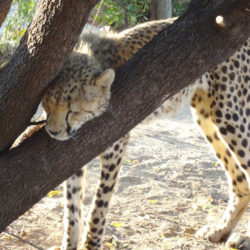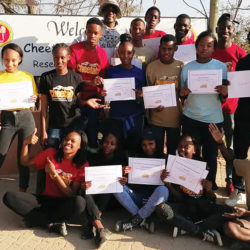Nambia University of Science and Technology Students Take on Work Integrated Learning at CCF
-

- by William Versfeld December 20, 2017

From the September to mid November 2017, three 3rd and final year Bachelor of Science (Biology major) student at Namibia University of Science and Technology (NUST) came for an internship at CCF. They were part of the Work Integrated Learning program developed by NUST to get their student into contact with work environment. While Rosalia and Usu spent their internship within the Ecology department, Erastus spent his 6 weeks as part of the genetics lab. Here is what they have to say of their experience at CCF.

Usutuaije Kouje Kazondunge (a.k.a Usu)
“I got the opportunity to be a part of the Ecology Department for about 6 weeks, working under the direct supervision of Stephanie and Gabriela. As with being an intern in the Ecology department, here is the work (or “projects”) that I was involved in: camera trapping photo-sorting, checking Hotspot cameras-every Monday and Thursday, game counts (day and night strip counts, waterhole counts), data entry and reserve guide (which I worked on with Rosalia) to help future or current interns with easy identification of the different animal species when sorting out pictures-camera traps identify animals from camera trap photos. I also got to conduct surveys with Gabriela and work in the Veterinary Clinic. Not only was I able to work in ecology department, I also got a chance to rotate through the daily tasks of each department to gain experience in each of those areas as well.
CCF is recognized as the world’s leading organization that has devoted itself to saving the cheetahs in the wild but I would also say that it is such a great training facility. I was able to apply the knowledge that I gained over the past three years (in my studies) in a much more practical manner which has taught me so much more than what I got to see and learn in a classroom and it has equipped me with the necessary skill set, not only in Ecology-related work but also in handling and working with animals most importantly, it opened my eyes to some of the human wildlife conflict issues that we face in this country and how each one of us can be of great help by getting involved or being a part of an organization such as CCF. Overall, I had a great working experience, I have learnt so much and I experienced so many things that I never thought or imagined I would. I am thankful to my supervisors, Stephanie and Gabriela for mentoring, teaching and taking the time to just make sure that I was well-equipped and to Dr. Laurie Marker who made this all possible by granting me this opportunity that I will forever be grateful for. ”
Rosalia Angula
“Being placed in Ecology department for 6 weeks gave me a chance to be involved in various data collection in field such as game counts (strips counts during the day and night and 12h at waterhole) and camera trap checking. I was also involved in data extraction through camera trapping photo sorting and data entry such rainfall, temperature, game counts data.
I liked the fact that there are kind and helpful supervisors: Gabriela and Stephanie made me cope within a week and the fact that they gave credit where it is due when I did well and then after told me to go fix where I went wrong and how to do it right. Working with them made my time at CCF a life time experience and something to talk about my internship.
Finally, what was interesting in ecology department was photo sorting because I saw variety animals during the day and during the night and also game count because I got to see animals physically.
Although I was placed in the Ecology department I was placed on the veterinary clinic to fill the tissues of dead cheetah with ethanol for preservation reasons, sealed since they are going to USA for further analysis. I was also involved in the general work of CCF like cleaning centre cheetahs pens, preparing meat for centre feeding, and taking care of the livestock guarding dogs.
I highly appreciate the opportunity that I was given to do my internship at CCF, giving special thanks to my supervisors, CCF staffs and fellow interns.”
Erastus Tuwilika Tobias
“I am a biology major student from the Namibia University of Science and Technology. I had the privilege to be part of the Cheetah Conservation Fund (CCF), Life Technologies Conservation Genetics Laboratory, as an intern for 6 weeks under the supervision of Dr Anne Schmidt-Kuentzel, William Versfeld and Monika Ndafuda.
I first got to know about CCF from my university lecture, Prof Percy Chimwamurombe. During my internship at CCF I was involved in several projects in the genetics laboratory. The technical workflow of what I got to do in and out of the laboratory is as follows; sample collection, DNA extraction, DNA sequencing, microsatellites, sperm collection and general tasks.
Samples were collected within and around CCF, namely scat, tissue and blood samples. In the genetics laboratory, I assisted with scat and tissue extractions. DNA extraction was subsequently done in separate rooms for scat and tissue samples to avoid contaminations, following instructions provided by the Qiagen Kit manufacturer. Scat samples tend to produce a low concentration and were something very tricky to work with. Once we have extracted the DNA we first had to identify the species of the scat.
The sequencing workflow starts with PCR by amplifying the mitochondrial DNA with the ATP6 marker and if we get bands on an agarose gel it indicates that our PCR worked, so we then do a PCR product clean-up. The sequence reaction follows, using a thermocycler, where after the sequences are cleaned and analysed on the Genetic Analyser 3130. The genetic analyser shows us the precise nucleotides for our sequenced DNA product, which we then compare to other known sequences. After we identify the species we are still not sure if it is the same or a different individual.
To do this I had to learn about microsatellites, which is solely done to identify individuals by using several markers. I also got involved in sperm collections from cheetahs under anaesthesia; semen was then evaluated under the microscope for mortality and status. During my time at CCF, I also got to do several general tasks such as; animal husbandry, game counts and night drives just to name a few of the very exciting opportunities I had.
My time at CCF was entirely benefiting and gained me valuable skills; it also paved my career path via mentorship by my NUST and CCF supervisors. I am more than thankful for the amazing lifetime experience.”
It was a great pleasure for us to have these 3 students with us. They were all very helpful and enthusiastic, very eager to learn. And while we hope that we have made a serious contribution to their future career path, they also help us a lot on our daily tasks.
We are now looking forward for a continued collaboration with the Work Integrated Learning program from NUST and for the next students to come and spend some time with us not officially on.
Students supervised by Dr Anne Schmidt-Kuentzel (Research Geneticist and Assistant Director for Animal Health and Research), Monika Ndafuda (Senior intern genetics laboratory assistant), William Versfeld (Lab technician), Stéphanie Périquet (Wildlife Ecology Research Manager) and Gabriela Fleury (Human Dimension Research Manager). Blog post compiled by William Versfeld (Lab technician), Stéphanie Périquet (Wildlife Ecology Research Manager) and Gabriela Fleury (Human Dimension Research Manager).
Related Reading
-
June 1, 2020
Two Trainings at CCF -
May 11, 2020
How Cheetahs Check Their Messages?




